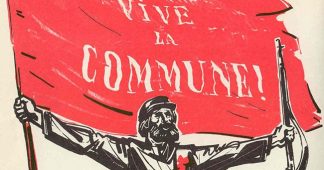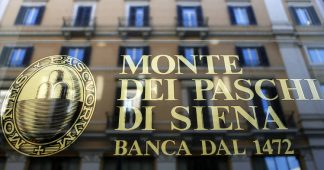by Eric Toussaint
21 March 2018
How well a country controls its banks has a profound effect on its history.
The Paris Commune was wrong to spare the Bank of France. Its main reserves and its governing body were within the territory of the Paris Commune. It was absolutely necessary to take control. By not doing so the leadership of the Paris Commune committed a serious error. [1]
In 1876, Prosper-Olivier Lissagaray, an intellectual activist who participated in the Communards’ struggle, denounced, in his book; ’History of the Paris Commune of 1871’, the attitude of the leadership. “The Council of the Commune…bent their knees to the budget of the bourgeoisie, which was at their mercy“, says Lissagaray, referring to the Bank of France. He says: ”All serious rebels have commenced by seizing upon the sinews of the enemy — the treasury. The Council of the Commune was the only revolutionary Government that refused to do so”. [2]
All that the Commune asked of the Bank of France was loans to maintain a balanced budget and a seamless salary payment for the National Guards (the National Guard of Paris was a citizen militia responsible for law enforcement and military defence). “As such, during its 72 days, the Commune received 16.7 million francs: 9.4 million assets held in the City’s accounts and 7.3 million actually lent by the Bank. At the same time, the people of Versailles received 315 million francs through the network of 74 Bank of France branches” (translation: CADTM), i.e. 20 times more. [3]
In 1881, ten years after the Paris Commune was squashed, Karl Marx echoed Lissagaray’s views. He believed that the Commune made a mistake in not taking over the Bank of France: “The appropriation of the Bank of France alone would have been enough to dissolve all the pretensions of the Versailles people in terror”. Regarding the appropriation of the Bank, this is what he had to say: “With a small amount of sound common sense… they could have reached a compromise with Versailles useful to the whole mass of the people — the only thing that could be reached at the time”. [4]
As Lissagaray wrote: “The members of the Council….had not seen the real hostages staring them in the face — the bank, the civil register, the domains and the suitors’ fund”. [5]
In 1891, Friedrich Engels added: “The hardest thing to understand is certainly the holy awe with which they remained standing respectfully outside the gates of the Bank of France. This was also a serious political mistake. The bank in the hands of the Commune – this would have been worth more than 10,000 hostages. It would have meant the pressure of the whole of the French bourgeoisie on the Versailles government in favor of peace with the Commune”.
To sum up, the Paris Commune of 1871 allowed the Bank of France to finance its enemies, i.e. the conservative Thiers government in Versailles and its army. [6]
The Russian revolution, bank nationalisation and the cancellation of the Russian peasants’ debts in 1917
Bank nationalisation was one of the first steps the Soviet Government took after the revolution of October 1917. This paved the way for the cancellation of the farmers’ bank loans, among other things. Foreign capitalists, mainly French and German, held 1/3rd of the banks’ capital. Seven leading banks were expropriated immediately. All bank shares were annulled. [7] The private banks were nationalised, while foreign debts considered illegitimate and odious were simultaneously repudiated. [8] Together, the expropriation of banks and the repudiation of debts fostered the budding revolutionary power.
In 1933, President F. Roosevelt firmly reined in the US banks
In March 1933 a major banking crisis erupted In the United States in the wake of the Wall Street crash of October 1929. Franklin Roosevelt, the newly elected President, closed the banks for a whole week. [9] In the same year he passed banking legislation known as the Glass Steagall Act, which separated deposit bank accounts from investment banking activities.
The Franklin D. Roosevelt government thus withdrew from the financial and banking communities the absolute freedom they had been enjoying. Led by this decision and under pressure from popular mobilizations in Europe during and after the Liberation, governments of the Old Continent set firm limits on capital activities. As a result, there were very few banking crises over the thirty years that followed the Second World War. Two North American neoliberal economists, Carmen M. Reinhart and Kenneth S. Rogoff pointed this out in their book entitled This Time Is Different: Eight Centuries of Financial Folly published in 2009. Kenneth Rogoff is a former chief economist with the IMF while Carmen Reinhart, a University professor, has been an IMF advisor as well as the chief economist on the World Bank’s advisory board. Clearly integrated into the capitalist system, these two economists nevertheless acknowledge that the low number of banking crises can be mainly explained “by the repression of the domestic financial markets (in varying degrees) and the heavy-handed use of capital controls that followed for many years after World War II”. [10]
In fact, during thesame period, the majority of the governments of the most industrialised countries implemented policies to regulate both the inbound and outbound capital flows. They also compelled the banks to behave prudently and partially nationalised the financial sector. As Reinhart and Rogoff acknowledge, in order to avoid bank failures, governments set “high requirements for bank reserves, among other devices, such as directed credit and minimum requirement for holding government debt in pension and commercial bank portfolios”.
France: the Bank of France and other structurally important banks are nationalised after the liberation
In France, bank nationalisation in the aftermath of the Second World War must “be seen as ‘a grassroots movement’ in the context of the Resistance (…) The Liberation led to the establishment of workers’ committees in some companies: factory committees behind a ‘spontaneous socialisation’” (Translation:CADTM). Patrick Saurin reminds us that on December 2, 1945, the Bank of France and four commercial banks were nationalised. The following year, on April 25, 1946, it was the turn of a number of insurance companies to be nationalised.
In L’ordre de la dette, Enquête sur les infortunes de l’État et la prospérité du marché ((in French) Debt Structure: Looking into the Misfortunes of the State and the Prosperity of the Market)) Benjamin Lemoine correctly points out “For more than twenty years following the Second World War, the state apparatus, through the internal Treasury circuit, garnered sufficient financial resources free from creditor pressure. With banking and finance under its control, the State harnessed its own treasury instruments to these regulations. Similarly, it attuned its finances with those national policies which determined the quantity of money and allocated resources to the economy”. [11] (Translation: CADTM).
Thanks to this policy, France was financially self-sufficient for nearly 40 years not having to depend on the good will of the financial markets, dominated by private banks and other financial institutions. Difficulties in banking were rare.
1959: in the very first year of the Cuban revolution, the government appoints Che as the president of the National Bank of Cuba
Appointing one of the main revolutionary leaders as the central bank’s chief clearly showed how important it was to control the country’s monetary and financial policy so that the Cuban people could triumph over the dictatorial Batista regime. The Cuban revolutionaries did not want to replicate the Paris Commune’s error. The control of the bank helped to achieve a bevy of significant social reforms that, supported by powerful popular mobilizations, definitely set off the Cuban revolution. [12]
France, 1982: bank nationalisation
The plan for nationalisation was part of the “Programme commun” co-signed by the Socialist Party (PS), the Communist Party and the Radical Movement of the Left on June 27, 1972. It featured in Presidential candidate Mitterrand’s “110 proposals” in 1980-81 (21st proposal). In his first seven year term of Presidency, François Mitterrand passed a nationalisation act (February 13, 1982), backed by the Mauroy government. Thirty-nine banks and a number of industrial and financial companies were nationalised (see the list).Mitterrand and his government promptly made an about-turn after this wave of nationalisations. The Banking Act of January 24, 1984 introduced a new banking system built on the model of the “universal bank”. It closed the gap between the commercial and investment banks and opened the door to deregulation. The banks were denationalised in 1986. [13]
The 2008 crisis in Europe and the United States
When the crisis of the private banking sector erupted in 2007-2008, several countries nationalised big private banks starting from 2008. This was done to avoid failures and to assist major shareholders. Major banks such as the Royal Bank of Scotland (GB), Hypo Real Estate (Germany), ABN-Amro in the Netherlands, Fortis, Dexia (now Belfius) in Belgium, Bankia in Spain, Banco Espirito Santo in Portugal etc. were nationalised. In no case has the government meaningfully redirected the activities of the nationalised entity towards the needs of the population. Often, the public authorities do not even take part in the directing of these institutions, leaving the administration to private representatives. None of these banks have been transformed into instruments to finance government investments. The nationalisation costs were paid from public finances, increasing public debt. The capital-serving governments would next want to re-privatise these banks. With their situation back in order, they are again attractive to the private sector. The CADTM and other organisations have been advocating an entirely different approach to face the banking crisis: refusing to save the bankers responsible for the crisis, expropriating the banks and transferring them to the public sector under citizen control without compensation for the major shareholders.
Greece 2015
As soon as the Tsipras government was sworn in it should have taken Immediate control of the banking sector. The Troika’s (European Commission, ECB and IMF) severe criticism of the failures since December 2014 and the ECB’s decision of February 4, 2015 had aggravated the banking and financial crisis.It was necessary to address the situation by implementing the Thessaloniki programme, for which, Syriza had been elected on January 25, 2015. The programme declared: “With a Syriza government, the public sector will regain its control over the Hellenic Financial Stability Fund (HFSF) and it will have rights over recapitalized banks. This means that the public sector will decide how the banks are run”. It should be noted that in 2015, the Greek State, by dint of the Hellenic Financial Stability Fund, was the main shareholder of the country’s four main banks encompassing more than 85% of the total Greek banking sector. The problem being that, despite several state recapitalizations of the Greek banks since October 2008, the state did not weigh on the banks’ decisions because its so-called preferential shares shares did not hold voting rights. The previous governments had not made any policy decision to that effect. Therefore, in keeping with Syriza’s promises, the Parliament should have transformed the preferential shares held by the public authorities into ordinary shares with voting rights. Then the state could have carried out its responsibilities and resolved the banking crisis in a perfectly normal and legal manner.
Three important steps should have been taken by the government. First, introduce controls on capital flows, to block capital from fleeing. Second, it was necessary to replace Stournaras as the Governor of the Bank of Greece. Third, implement a parallel payment system.
Tsipras and Varoufakis left the banks untouched and did not suspend debt payment. This decision has immensely harmed the Greek people. A historic opportunity has been lost. It must not happen again.
Translated by Suchandra De Sarkar and Mike Krolikowski
Footnotes
[1] A period of insurrection in Parisian history, lasting just over two months, from March 18, 1871 to the “Bloody Week” of May 21-28, 1871. The Parisian people rejected the French bourgeoisie’s capitulation to the German army that had reached Versailles, and proclaimed the Paris Commune, supported by the National Guard. Radical social measures were implemented, especially under popular demand. This is one of the first proletarian revolutions in history.
[2] See The History of the Paris Commune of 1871, by Prosper-Olivier Lissagaray, Paperback, 464 pages, Verso 2012, (first published 1896). We have quoted from Chapter xiv of Eleanor Marx’s translation freely available online at https://www.marxists.org/history/france/archive/lissagaray/ch14.htm
[3] Georges Beisson, “La Commune et la Banque de France” (in French), Association des Amies et Amis de la Commune de Paris 1871, http://www.commune1871.org/?La-Commune-et-la-Banque-de-France
[4] Karl Marx’s letter dt. February 22, 1881 to F. Domela Nieuwenhuis https://www.marxists.org/archive/marx/works/1881/letters/81_02_22.htm
[5] The History of the Paris Commune of 1871, by Prosper-Olivier Lissagaray https://www.marxists.org/history/france/archive/lissagaray/ch14.htm
[6] The officials of the major Parisian investment banks running the Bank of France celebrated the Commune’s fall by announcing a dividend of 300 francs per share to the shareholders, against 80 francs in 1870.
[7] Edward H. Carr, La révolution bolchevique, Volume 2. L’ordre économique (in French), published by Éditions de Minuit, Paris, 1974, Chapter 16, p. 146.
[8] See Russian debt repudiation, 100 years on by Nathan Legrand and Éric Toussaint, http://www.cadtm.org/Russian-debt-repudiation-100-years. For a more detailed analysis of debt repudiation see Centenary of the Russian Revolution and the Repudiation of Debt, Éric Toussaint, http://www.cadtm.org/Centenary-of-the-Russian
[9] Isaac Joshua, Une trajectoire du Capital, Paris, Syllepse, 2006, p.19. (in French)
[10] Carmen M. Reinhart, Kenneth S. Rogoff, This Time Is Different: Eight Centuries of Financial Folly, 2009, Princeton University Press, p. 205.
[11] Benjamin Lemoine, L’ordre de la dette. Enquête sur les infortunes de l’État et la prospérité du marché (in French), La découverte, Paris, 2016
[12] For the initial phase of the Cuban revolution, see Fernando Martinez Heredia: Du 19e au 21e siècle : une mise en perspective historique de la Révolution cubaine (in French).For Che at the helm of Cuba’s central bank, see http://www.radiorebelde.cu/especiales/che/el-che-guevara-como-presidente-banco-nacional-cuba-20141126/ and http://banconacionaldecuba.com/ernesto-che-guevara/ (both in Spanish)
[13] Patrick Saurin, http://www.cadtm.org/Pourquoi-la-socialisation-du (in French)
* Eric Toussaintis a historian and political scientist who completed his Ph.D. at the universities of Paris VIII and Liège, is the spokesperson of the CADTM International, and sits on the Scientific Council of ATTAC France.
He is the author of Bankocracy (2015); The Life and Crimes of an Exemplary Man (2014); Glance in the Rear View Mirror. Neoliberal Ideology From its Origins to the Present, Haymarket books, Chicago, 2012 (see here), etc.
See his bibliography: https://en.wikipedia.org/wiki/%C3%89ric_Toussaint
He co-authored World debt figures 2015 with Pierre Gottiniaux, Daniel Munevar and Antonio Sanabria (2015); and with Damien Millet Debt, the IMF, and the World Bank: Sixty Questions, Sixty Answers, Monthly Review Books, New York, 2010. Since the 4th April 2015 he is the scientific coordinator of the Greek Truth Commission on Public Debt.
Published at http://www.cadtm.org/Socialising-the-banks-some











